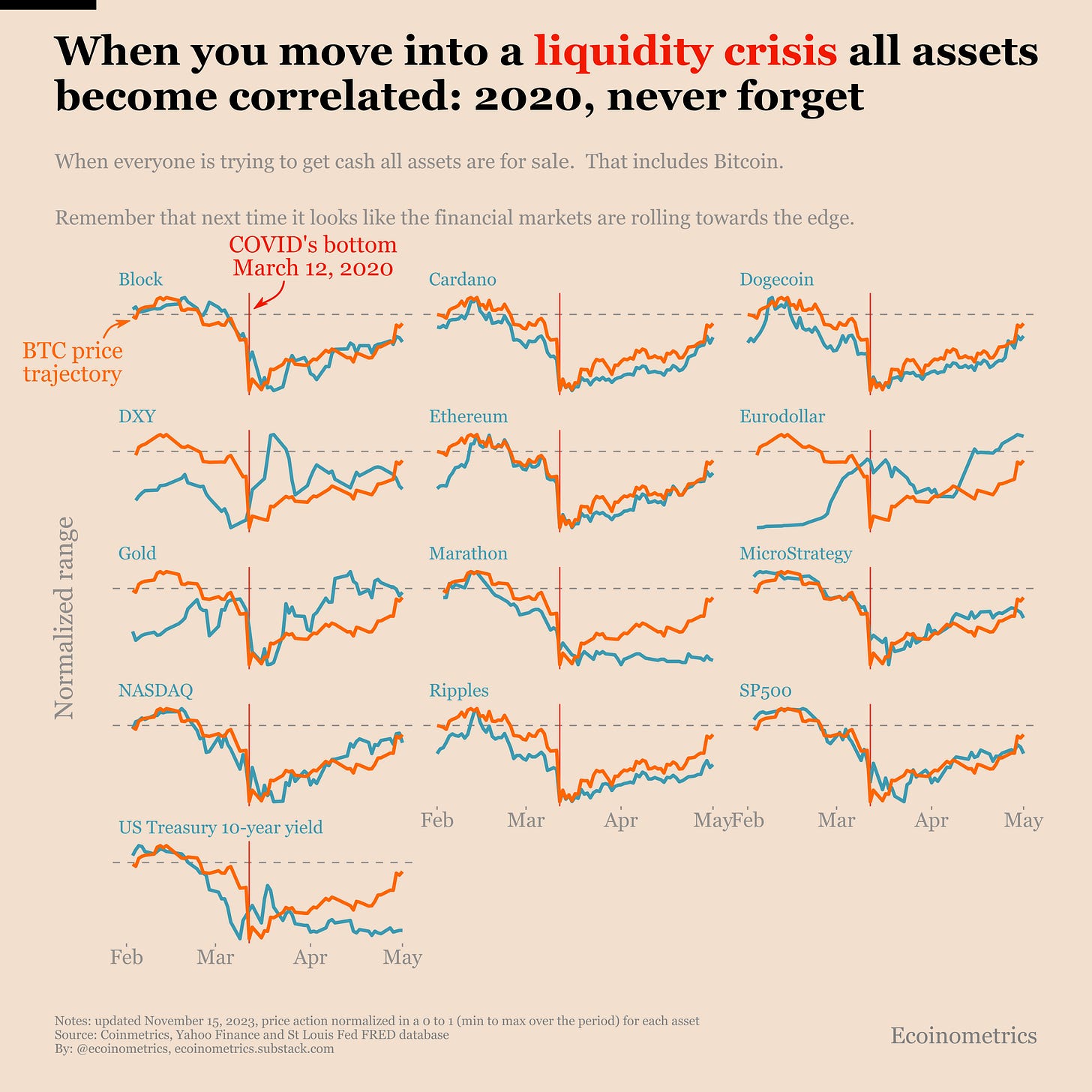Bitcoin is falling behind on the halving cycles
Also don’t forget the liquidity crisis and is the tightening canceled.
Welcome to the Friday edition of the Ecoinometrics newsletter.
Every week we bring you the three most important charts on the topics of macroeconomics, Bitcoin and digital assets.
Today we'll cover:
Bitcoin is falling behind on the halving cycles.
Remember the liquidity crisis.
Tightening canceled.
Each topic comes with a small explanation and one big chart. So let’s dive in.
In case you missed it, here are the other topics we covered this week:
Those research notes are for paid subscribers only. If you aren’t a paid member, now is a great time to upgrade. You just have to click on the button below.
Bitcoin is falling behind on the halving cycles
Around the time of the last halving in 2020 I started tracking how Bitcoin’s growth trajectory post-halving compared to the past cycles.
Remember May 2020:
The Federal Reserve is in full QE mode to compensate for the COVID crisis.
The narrative around the stock-to-flow model is in full force.
Bitcoiners are already talking about the risk of inflation.
Based on that it is reasonable to think that the environment is right for Bitcoin to deliver as much return as it did in the past couple of cycles.
Target? Anywhere between $100,000 and $300,000 per Bitcoin by the the end of the cycle.
For a while everything was well on track. But a few months in, the top was pretty much already in. And Bitcoin ended far below $100k.
Another cycle, another round of diminishing returns…
Now maybe that’s the correct interpretation. Or maybe not. But I want to point out that diminishing returns aren’t a curse. The largest tech companies such as Apple are pretty much immune to it at this point. And Bitcoin is large enough that diminishing returns should stop being a concern.
What that means is that for the upcoming cycle, while the top of the range of historical returns is unlikely, the bottom of the range is realistic. That still push BTC at $100k+ per coin over the next ~4 years.
Don’t forget the liquidity crisis
Making long term macro bets is much easier than day trading. You figure out a big trend, you seek out how to benefit from it as much as possible, you invest. After that macro bets are like watching paint dry.
That being said it isn’t like you have nothing to do at all. As a matter of fact your number one goal is to give your portfolio enough room to survive and benefits from your long term view.
For that I recommend keeping in mind that when the market moves into a liquidity crisis all assets become correlated. Last time that happened for in 2020.
When everyone is trying to get cash, all assets are for sale. That includes Bitcoin. So don’t make the mistake of thinking your are diversified. That won’t matter in this situation. What matters is that you only have liquid positions.
Tightening canceled
But is the US really moving towards a recession? Because, maybe you haven’t heard, but the Federal Reserve tightening is canceled…
I’m talking about the credit conditions specifically.
The National Financial Conditions Index tracks the state of the financial conditions in the US relative to its average over the past 50 years.
A positive value indicates conditions tighter than the average. A negative value indicates conditions looser than average.
Focusing on the credit part of the NFCI index the Quantitative Tightening sequence the Federal Reserve is running since 2022 has brought the credit conditions from looser than average to tighter than average.
The idea is that with credit harder to come by the US economy should start slowing down enough to get inflation under control. With the Federal Reserve maintaining pressure with its “higher for longer” rates policy that’s guaranteed to happen.
Except… Well except that since the Federal Reserve has been showing sign that they are close to the terminal rate of this rate hike sequence the credit component of the NFCI has been trending back down towards average credit conditions.
Give it a couple of weeks and it should be there. We are already back to credit conditions similar to that of 2022. A few more months of that trend and the credit conditions will be classified as loose again…
This is not what the Federal Reserve is trying to achieve. If the US isn’t already entering a recession by then the FOMC might decide to tighten the screw again. So let’s see how that plays out.
That’s it for today. I hope you enjoyed this. We’ll be back next week with more charts.
Cheers,
Nick
P.S. We spend the entire week, countless hours really, doing research, exploring data, surveying emerging trends, looking at charts and making infographics.
Our objective? Deliver to you the most important insights in macroeconomics, Bitcoin and digital assets.
Armed with those insights you can make better investment decisions.
Are you a serious investor? Do you want to get the big picture to get on the big trades? Then click on the button below.




